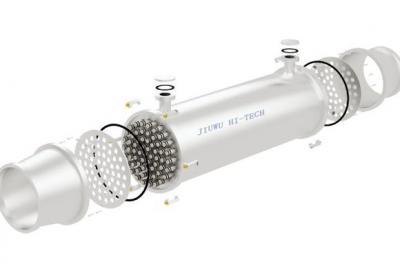Nanofiltration membranes are becoming increasingly popular due to their many benefits, one of which is their ability to kill bacteria. So, what are the different methods of bacterial sterilization for nanofiltration membranes?
Physical methods of bacterial sterilization for nanofiltration membranes include heating, osmotic pressure, radiation, and filtration. Chlorination of ultrapure water systems is an effective method of killing bacteria in water. Chlorine reacts with water to produce hypochlorous acid, ozone, chlorine dioxide, alcohol, and descaling agents. Low pH values are more favorable for hypochlorous acid production. At higher pH values, hypochlorous acid dissociates into hypochlorite ions.
Hypochlorous acid has a strong bactericidal effect. It can penetrate bacterial cell walls and destroy them. The oxidizing power of the hypochlorite ion is 100 times that of hypochlorous acid, so high pH values are not conducive to sterilization (because hypochlorite ions are quickly reduced, which does not allow time to kill bacteria). Equivalent sterilization methods include ozone treatment and UV oxidation.
Chemical methods of bacterial sterilization for nanofiltration membranes include ozone, chlorine, alcohol, and descaling agents.
UV oxidation is another method of bacterial sterilization for nanofiltration membranes. When exposed to UV radiation, bacteria's DNA is modified, and this process is irreversible. Bacteria's DNA is easily irradiated by UV radiation, so the entire bacterium is deactivated. The power of UV lamps to deactivate bacteria depends on the type of lamp, the duration of exposure, and the water's residence time and flow rate through the UV lamp.
When installing nanofiltration membranes, there are a few things to keep in mind. Nanofiltration membranes are a special and promising variety of separation membrane that is named after its ability to retain substances of around nano-sized dimensions. They are used to remove organic matter and color in surface water, remove hardness in groundwater, partially remove dissolved salts, concentrate fruit juices, and separate useful substances from drugs.
Rinse the new membrane with permeate water for two hours after initial installation and discard the water.
Avoid back pressure when the membrane element is producing water.
When pH values are greater than 10, temperatures are continuously running at 35℃, or free chlorine or other oxidizing substances are present in the influent water, the membrane's performance may be severely affected due to its oxidative properties.
If the pressure drop of the membrane element is 1.5 times greater than the initial value, the membrane element must undergo chemical cleaning.
All nanofiltration membranes undergo strict water testing before leaving the factory and then vacuum packed with a 1% solution of sodium bisulfite to protect the membrane elements and prevent microbial growth.




 +86-25-58849045
+86-25-58849045
 +86-25-58749295
+86-25-58749295
 jiuwu@jiuwu.com
jiuwu@jiuwu.com
 No. 9 Park Road, Pukou District, Nanjing City (Sanqiao Factory)
No. 9 Park Road, Pukou District, Nanjing City (Sanqiao Factory) Call us on:
Call us on:  Email Us:
Email Us:  No. 9 Park Road, Pukou District, Nanjing City (Sanqiao Factory)
No. 9 Park Road, Pukou District, Nanjing City (Sanqiao Factory)

 English
English 한국어
한국어 français
français русский
русский Español
Español

